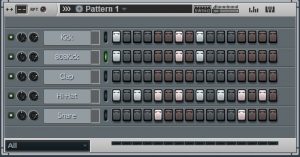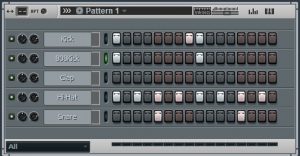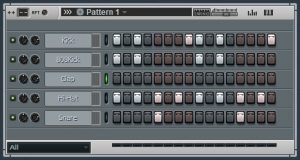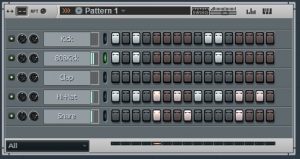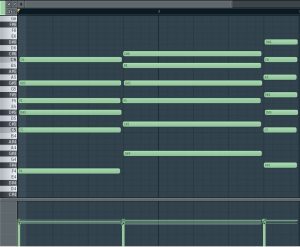EDIT: This tutorial is a bit outdated. I no longer use some of the techniques I presented in this article. Some of them I still use though.
G-Funk is a sub-genre of hip hop music that developed from the West Coast hip hop of the early 1990s. It is well known for using elements of funk music and even samples from funk music with an artificially lowered tempo, deep basslines and the genres signature high pitched whine synthesizer. Between 1992 and 1996, G-Funk was the dominant genre in hip hop music.
If you want to make G-Funk beats, first youll need a digital audio workstation software like Reason, FL Studio, Cubase etc. Since I use FL Studio, this guide will be based on it. Next you need the sounds you hear usually in G-Funk and Funk music, stuff like drums, electric pianos, basses, guitars and synths. For drums, you could get them from sampling drum breaks from funk and soul records, but it doesnt really matter that much, you can make a G-Funk beat with any drum sounds you have available. If you can, you can always record your own live drums. For electric pianos, you can use a VST plugin like Lounge Lizard or Lazysnake, you can record your own if you have one available, or use a sample. If you need a funky guitar riff, you can use VST plugins such as RealStrat, RealLPC or Rob Papens RG, but the best option is to get a guitar player to play for you (or play it yourself). For bass, if you dont have a bass guitar to record, you can use either a synth plugin or a bass plugin like Trilian. If you want to make G-Funk beats, its mandatory to have some type of synth, preferably a Minimoog synth. If you dont have one available to record, use a plugin called MinimogueVA. You can use that plugin for both synth sounds and basses. For strings, use Edirol Orchestral (which has multiple orchestral instruments) or DSK Strings (only has strings).
Drums
The drum patterns in G-Funk beats are pretty simple. The less kicks you use in your drum patterns, the more they will thump, because you give the kick enough time to decay, so it creates a difference in volume levels. Here are some drum patterns examples.
Drum Pattern 1
Drum pattern 2
Drum pattern 3
Drum pattern 4
Drum pattern 5
Drum pattern 6
If you want to give your kicks some extra boom, you might want to layer it with an 808 Kick. Just make sure you make the 808 Kick monophonic, so it wont distort on itself. Just go to MISC and click on Cut itself. And you could also add some gated reverb on the 808, use a plugin called Omniverb. Select a preset called Gated Reverb and turn the Gate Sensitivity to around 90%, Hold to around 10-30ms and FX mix level in the mixer effect slots to around 40%. Be careful how you mix the 808 kick, since the low frequencies can clash with your bassline.
808 kick settings
Omniverb settings
Another thing I sometimes do, is to layer the snare with a pitched down clap and most of the time, I add a bitcrusher effect on my kicks, snares, claps and hi hats, but not on the 808 kick. Use CMT Bitcrusher VST, set bit-depth to either 12bit or 16bit, downsampling to 2x and turn up the drive to whatever you like. Then add a Parametric EQ after the bitcrusher in the mixer effects slot and cut out the very high frequencies above 14000-15000Hz. I always cut the low frequencies on the snare and hi-hats so they dont clash with the bass and kick drum.
Bitcrusher settings
Chord Progression
You can use pretty much any chord progression on your instrumental. The best chords to use in G-Funk music are the seventh chords. Take any chord progression and make every chord in it a seventh chord and you will instantly make it sound smooth, especially if you use it on an electric piano.
Chord progression example:
Electric Piano
If you use an electric piano in your song, here are some tips:
1. Use a chorus effect on it it will make it sound wider.
2. Cut off the low frequencies so it wont clash with the bass.
3. If you want a different sounding electric piano, use a tremolo effect, or a wah-wah effect on it.
4. Add a slight distortion to it. For this, I use a VST plugin called JB SEND. It has a nice preset called Add warmth, but I only use it with 5%-15% mix level.
Bass
The easiest way to make an effective bassline is to follow the chord progression. So if your chord progression is C-F-G, just play C-F-G on the bass in time with the chord progression. As for mixing, I usually put a slight reverb on the bass and I don’t cut or boost any frequencies.
Lead Synth
This is the most important part of the G-Funk music, since is regarded as being the signature instrument. For this, I use a VST plugin called MinimogueVA. If you want to get a basic lead, first turn off OSC2 and OSC3, Then turn the Cutoff and Emphasis to around 5. Next at the Filter Contour and Loudness Contour sections, turn the Attack all the way down and Decay and Sustain all the way up. You can also use this as a bass with some adjustments turn the cutoff down a bit, and the set Delay level to 0, and play it low on the keyboard.
MinimogueVA settings
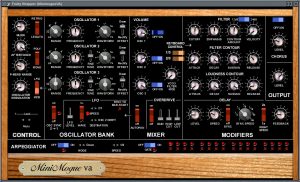
Make sure you set it to Legato before you start playing and when you play your synth melody make sure your notes overlap so you get that glide effect. If you want to modify the time it takes to slide from one note to the next, you can adjust it from the Glide button.
Guitar
Funk music is more about rhythm than it is about melody. You dont need to play a complicated melody on the guitar. Just a couple of notes or chords with the right timing can make it sound very funky. For extra funk, add a wah effect on the guitar.
Some more tips:
1. Just do whatever sounds good to you. This way you will develop your own unique sound.
2. When it comes to mixing, I always cut the low frequencies on all the instruments with the exception of the kick drum, bass, and 808 kick in order to prevent frequencies from clashing.
3. If you want to make G-Funk beats, and not only G-Funk, this applies to all genres of hip hop music, you need to start learning music theory.
You can use some of the things in this guide not only for G-Funk beats, but also for other types of hip hop instrumentals.
If you dont know how to produce your own rap instrumentals, and you dont want to learn how to make hip hop beats, you can always buy instrumentals at affordable prices.

